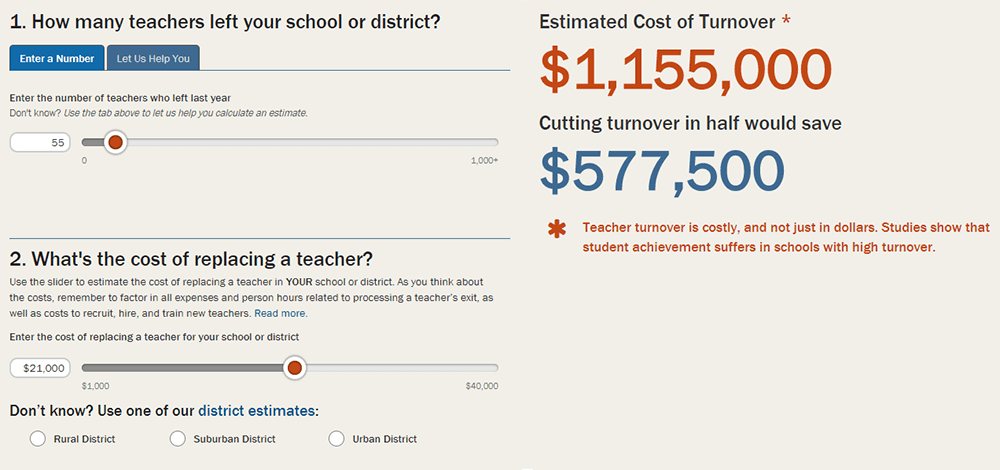Let’s Talk: Starting a Conversation About Teacher Turnover

Each year, tens of thousands of teachers transfer to new schools or districts. They pack up their classrooms and say goodbye to colleagues, students, and families, often in pursuit of improved working conditions, a more supportive principal, or higher pay. A similar number of teachers annually leave the profession entirely. Some are retiring, but most are leaving because of dissatisfaction with their job.
Altogether, about 16% of teachers move jobs or leave teaching annually, and the numbers are much higher in the communities with the greatest needs. The rate of teachers leaving the profession each year far surpasses that in high-achieving countries—more than double the attrition of teachers in Finland, Singapore, or Ontario, Canada—all of which experience surpluses, rather than shortages, of teachers.
Teacher turnover—or churn—is nothing new. Researchers have been studying it for decades, analyzing data to understand the causes and put forth solutions to improve retention and create a strong and stable teacher workforce. Two new resources from the Learning Policy Institute build on this body of work, offering new insights and tools to understand and address the problem, which comes with a high price tag. First, there’s the financial impact of turnover—the estimated average cost to replace each teacher who leaves an urban school district is more than $20,000. As importantly, turnover impacts the achievement of all students in a school, not just those with a new teacher, by disrupting school stability, collegial relationships, collaboration, and the accumulation of institutional knowledge.

In Teacher Turnover: Why It Matters and What We Can Do About It, authors Desiree Carver-Thomas and Linda Darling-Hammond do a deep dive into the 2012 Schools and Staffing Survey and the 2013 Teacher Follow-up Survey (the most recent of two nationally representative surveys) to investigate how turnover trends vary across teachers and schools. Their analysis shows that two key causes of turnover are the quality of preparation teachers receive prior to entering the classroom and the amount and quality of administrative support they receive once they’ve begun teaching. Pay—specifically the competitiveness of district salaries—also plays a critical role in a teacher’s decision to leave a school or district. Teachers of mathematics, science, special education, English language development, and foreign languages—areas of persistent shortages—are more likely to leave their school or the profession than those in other fields.
As important, the report details how teacher turnover is experienced more acutely by some students and communities than others. Namely, turnover rates are 50% higher for teachers in Title I schools, which serve more students from low-income families, and a full 70% higher for teachers in schools serving the largest concentrations of students of color. The revolving door of teachers, especially in these schools, which typically have fewer resources and less favorable working conditions, undermines efforts to enhance school climate and conditions and to close opportunity gaps and improve academic outcomes for the students they serve.
To be sure, some teacher turnover is to be expected in all schools. It can even sometimes be beneficial, particularly if it allows teachers to find schools or professions that are the right fit. But the turnover rates in many U.S. schools and districts exceed the natural sorting and shifting that occurs in any profession. They reflect systemic challenges and require systemic solutions.
Generally, in times of teacher shortages, policymakers in the U.S. have focused their attention on strategies to beef up recruitment, even though improving retention is more critical to solving shortages in the long run. One reason for this unbalanced approach is that teacher turnover is often an invisible problem, whose real costs are unknown to parents, the public, and policymakers themselves.
That’s why LPI has also created a new calculator tool to help schools, districts, and the communities they serve begin to understand the local cost of teacher turnover, particularly its drain on limited financial resources. The estimated costs to replace a teacher range from about $9,000 on average in a rural district to, on average, more than $20,000 in an urban district, drawing on the results of multiple studies that have evaluated what it costs to process a teacher’s exit, as well as costs to recruit, hire, and train new teachers. The calculator uses this available research and data to provide estimates for turnover costs in rural, suburban, and urban districts that we hope will jump-start a local conversation about the extent and causes of teacher turnover. As importantly, the tool and related resources are designed to connect education leaders, policymakers, and community members to evidence-based policies and practices for addressing their particular challenges in recruiting and retaining teachers.
For every child to thrive, we need a thriving teacher workforce whose members are prepared, supported, and fairly compensated. It’s time to start a conversation—and then take action to build a strong and stable teacher workforce. The stakes couldn’t be higher.
